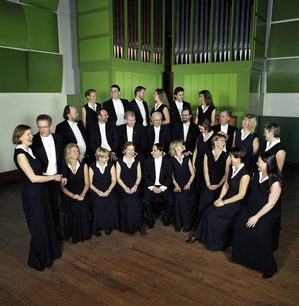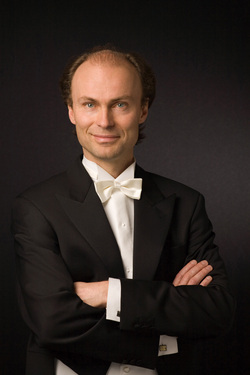Swedish Radio Choir to show its stuff a cappella
Back in 2001, when the Swedish Radio Choir made its Ann Arbor and University Musical Society debut, it appeared at Hill Auditorium in glorious symphonic mode. The fare was the Verdi Requiem, which the group performed with the Swedish Radio Orchestra to a rapturous reception.

Swedish Radio Choir perform at Hill Auditorium on Sunday.
Photo courtesy Swedish Radio Choir.
Now, the full 32-voice choir returns to town in a cappella mode, in repertoire for voices alone. Under UMS auspices once again, the renowned choir returns to Hill Auditorium for a concert that demonstrates the depth and breadth of its prowess in this repertoire.
“It’s one of the leading a cappella ensembles,” says guest conductor Ragnar Bohlin, a Stockholm native who is choral director for the San Francisco Symphony and who has been a frequent conductor of the Swedish Radio Choir over the years.. “They’re very experienced in everything from music of the 1500s to contemporary repertoire.”
What makes them so exceptional?
“They have an amazing sense of style,” Bohlin said by phone from California recently. “And singing a cappella, of course, requires a lot of finesse in terms of blending and all those delicate aspects that need to be honed for a cappella music to be at its best. That’s where they really excel.”

Guest conductor Ragnar Bohlin leads the Swedish Radio Choir in their Sunday concert at Hill Auditorium.
Photo courtesy Swedish Radio Choir
The program they sing here doesn’t quite reach back to the 1500s. J.S. Bach (1685-1750) is the earliest composer on the Sunday’s list of musical luminaries; the choir performs what Bohlin calls “arguably Bach’s most popular motet, certainly the most jubilant with all its virtuosic coloraturas, “Singet Dem Herrn.”
The emphasis, rather, is on Scandinavian works and on works of the 20th and 21st centuries, with works by Hugo Alfven (“Eve”); Ned Rorem (“In Time of Pestilence”); Mahler (a choral arrangement of “ Ich bin der Welt abhanden gekommen”); Sven-David Sandström (“Lobet den Herrn”); Anders Hillborg (“Mouyiyuom”); and Frank Martin (“Mass for Double Chorus”).
The Sandström piece, a motet from 2003, is based on Bach. “Lately,” said Bohlin, “he has had a focus on composing in the same forms as Johann Sebastian Bach, though with his own tonality and style.” And the Hillborg “Mouyiyuom,” which begins the second half, is “a very spectacular bass meditation, an indescribable piece, just sounds, no words, a cosmic meditation,” Bohlin said. The Martin mass has been hailed as a 20th century landmark — albeit one that began to make its mark some 40 years after it was written: Martin withheld it, deeming it unworthy.
Bohlin, who leads the choir on its current North American tour, had a hand in planning the program, and though he is reluctant to declare a theme for the concert, he agrees that it does have something of “an arch from beginning to end.” “I sort of hesitate to say it,” he said. “But I love for there to be a direction in a program, not only in musical content but also in textual content.
PREVIEW |
“The program starts romantically, with a nature depiction of evening and sunset, in a very simple folk music style. It’s very serene and calm. Then things get very dark in the Rorem. He sets the English Renaissance poet Thomas Nashe, and the piece is about death and despairing. It has lots of existential layers, though of course it’s correlated to times of pestilence.
“The Mahler, a setting for double chorus by a German arranger, is about detachment from the world. And then, with the Bach and the other motet and the Martin mass, things get more religious. There is a movement from dark to light. That’s sort of the direction. I wouldn’t put too much emphasis on it, but when I selected the order of pieces, that’s the way I looked at it.”
Whether the audience hears it that way or not, it should be a memorable afternoon of music and music making.
Susan Isaacs Nisbett is a free-lance writer who covers classical music and dance for AnnArbor.com.
Swedish Radio Choir performing live in Belgium last fall:

